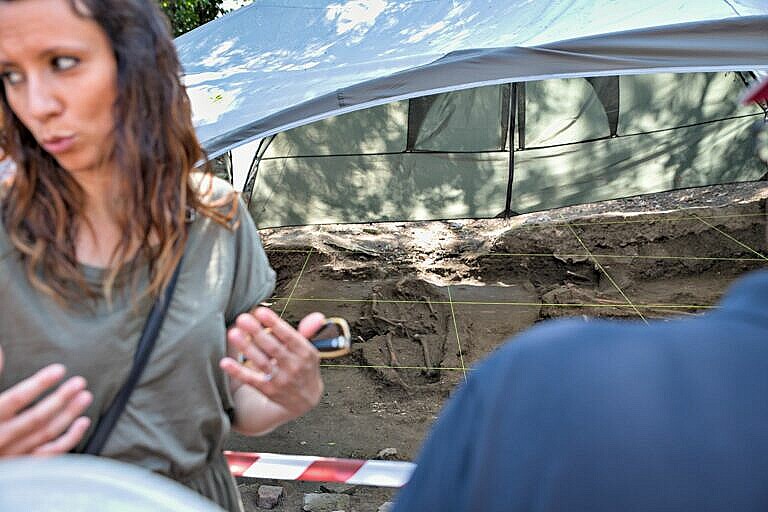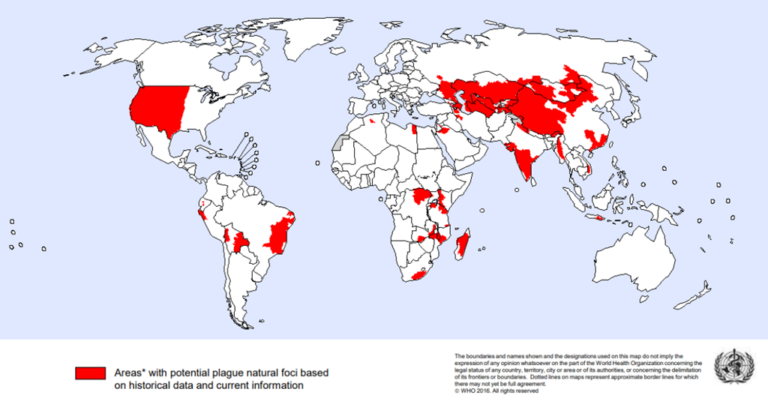The black plague — or bubonic plague — is caused by a bacterium, yersinia pestis.
The black plague ravaged Venice for centuries, and had a huge impact on life in the city.
The disease
It can be transmitted by blood, often through flea bites. The black rat, which was very common in the Mediterranean basin in the Middle Ages, was often be infected but the infection wouldn’t hurt the rat. However, fleas living on the rat could then bite humans, and thus transmit the decease. In humans the decease has a 30-50% mortality rate.
The infection can also arrive through the lungs, as pneumonic plague. In this case the mortality rate is higher still.

An infection of the black plague initially resembles a very bad flu, with high fever and muscle pains. When the infection reaches the lymph nodes in the groin and armpits, they swell and go black. This is what has give the yersinia pestis infection the names black plague or bubonic plague. The swelled lymph nodes can burst open releasing a pus containing the bacteria.
Often victims get gangrene in the fingers, toes, lips and nose, which will turn blue or black.
Spread of the Black Plague
Epidemics of the black plague hit Europe from the 500s until the 1700s when it mostly disappeared. One of the last outbreaks was in 1793 on the island of Poveglia – or Lazzaretto Nuovissimo.
The people of Europe had little understanding of the medical and scientific reasons for the plague, but tried to prevent the spread of the decease through surveillance and quarantine. The Lazzaretto Vecchio and the Lazzaretto Nuovo had central roles in preventive measures.

The black plague still exists outside of Europe. There have been recent cases in North America, Central Asia and Madagascar. It is treated with antibiotics.
In Europe the brown rat, which doesn’t carry the bubonic plague, has mostly supplanted the black rat. This is one of the reasons why the bubonic plague subsided in Europe during the 1700s.
Related articles
- The Venetian Lazzaretti
- Lazzaretto Vecchio
- Lazzaretto Nuovo – the first quarantine station
- Poveglia – more than ghost stories
- Bad air will get you sick
Venetian Stories
- Episode 17 — Venice and the plague – part 1
- Episode 18 — Venice and the plague – part 2
- The Plague Stone of Poveglia
- Quarantine in the 1600s
- Lazzaretto Vecchio – six centuries
Sources
- The start of the plague in 1575 — Cornelio Morello (1584)
- Francesco Pona — The Plague in Verona, 1630
- Capitoli Da osservarsi nelli Lazaretti — 1674
- Antonio Moro and the Somachio
Localities
Bibliography
- Fazzini, Gerolamo (ed.). Venezia : isola del Lazzaretto Nuovo in Guide archeologiche della Laguna di Venezia. Archeoclub Venezia, 2004. [more]
- Fazzini, Gerolamo (ed.). I Lazzaretti Veneziani : il sistema sanitario della Serenissima contro le epidemie. Marcianum Press, Venezia, 2024. [more]
- Green, Monica H. Plague (Yersinia Pestis) in Encyclopedia of the History of Science, May 2024. 2024. 🔗
- Magistrato alla Sanità. Capitoli Da osservarsi nelli Lazaretti Stabiliti, e decretati Dagl’Illustrissimi, & Eccellentissimi Signori Sopraproveditori, Aggionti, e Proveditori alla Sanità. Venezia, 1674. [more]
- Pona, Francesco. Il gran contagio di Verona nel milleseicento, e trenta. Descritto da Francesco Pona. In Verona per Bartolomio Merlo. Stampator camerale, 1631. [more] 🔗
- Vanzan Marchini, Nelli-Elena. Guardarsi da chi non si guarda : la Repubblica di Venezia e il controllo delle pandemie. Sommacampagna : Cierre, 2022. [more]


Leave a Reply